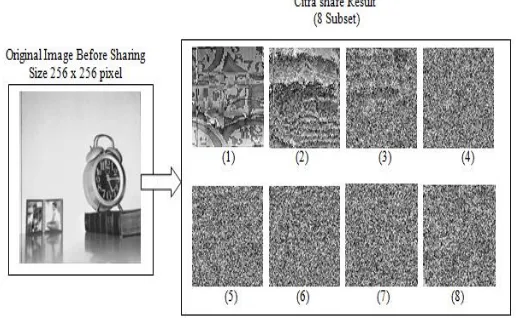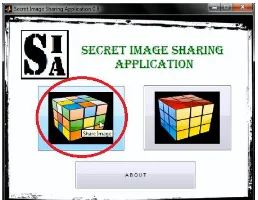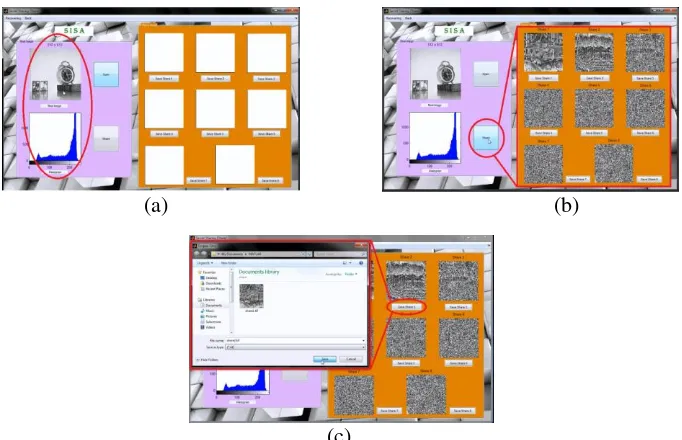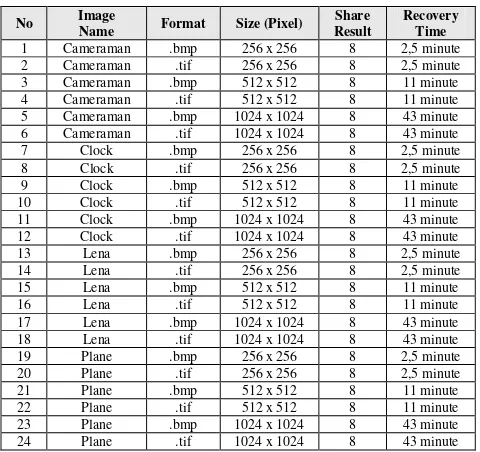Journal of Physics: Conference Series
PAPER • OPEN ACCESS
Encryption On Grayscale Image For Digital Image
Confidentiality Using Shamir Secret Sharing
Scheme
To cite this article: Rodiah et al 2016 J. Phys.: Conf. Ser.710 012034
View the article online for updates and enhancements.
Related content
Colour Based Image Processing Method for Recognizing Ribbed Smoked Sheet Grade
Ike Fibriani, Sumardi, Alfredo Bayu Satriya et al.
-Utilization of Digital Image Processing In Process of Quality Control of The Primary Packaging of Drug Using Color Normalization Method Danang Erwanto, Sri Arttini Dwi Prasetyowati and Eka Nuryanto Budi Susila
-Investigation of phase objects using off-axis digital holography with a-priori known information on the reference wave A V Belashov, N V Petrov, I V Semenova et al.
Encryption On Grayscale Image For Digital Image
Confidentiality Using Shamir Secret Sharing Scheme
Rodiah, Dyah Anggraini, Fitrianingsih, Farizan Kazhimi
Department of Informatics, Gunadarma University, Depok, Indonesia.
{rodiah,d_anggraini,fitrianingsih}@staff.gunadarma.ac.id,[email protected]
Abstract The use of high-frequency internet in the process of exchanging information and digital transaction is often accompanied by transmitting digital image in the form of raster images. Secret sharing schemes are multiparty protocols that related to the key establishment which provides protection against any threats of losing cryptography key. The greater the key duplication, the higher the risk of losing the key and vice versa. In this study, Secret Sharing Method was used by employing Shamir Threshold Scheme Algorithm on grayscale digital image with the size of 256x256 pixel obtaining 128x128 pixels of shared image with threshold values (4,8). The result number of shared images were 8 parts and the recovery process can be carried out by at least using 4 shares of the 8 parts. The result of encryption on grayscale image is capable of producing vague shared image (i.e., no perceptible information), therefore a message in the form of digital image can be kept confidential and secure.
1. Introduction
Confidentiality is very crucial aspect in information exchange. It requires a security process to keep the privacy hidden. One of the forms of information that can be maintained to be hidden or confidential is in the form of images. As the use of internet is frequently high in the process of exchanging information and digital transaction, sending digital image in the form of raster images is often carried out. One of the methods used in image encryption is Secret Image Sharing. The Secret Image Sharing Method is one of the types of encryption that used to encrypt information in the form of images. This method divides the image into several sections or subsets. Each section (subset) does not have any perceptible information (i.e., vague) and the original image can only be generated by combining the divided sections (subsets) [1]. Secret Sharing Schemes are multiparty protocols that related to the key establishment which provides protection against the threat of losing cryptography key. The greater the duplication of the key makes the risk of losing the key become higher and vice versa. Secret Sharing Scheme overcomes this problem without increasing the number of risks. It can also be used to distribute trust or shared control of critical activity with the intervention of only t of n users [2].
Previous studies related to Secret Image Sharing, among others, is the implementation of Secret Image Sharing on compressed files using Huffman Algorithm [3]. This Algorithm was analogized as the key to open the Huffman file. Shamir Secret Sharing was sufficiently adequate to be used to share general data. Unfortunately, in terms of size, Huffman Algorithm was less effective as the size of the shared data was equal to or greater than the size of the confidential data. Hence, the required size of the overall shared data was n times greater than the size of the source. Secret sharing method was used normally in encoding. The header bytes of the data were encrypted using the Shamir secret sharing, or representing Huffman tree (graph) as matrix and then secret sharing, specifically for matrix, was conducted or in other words variation of visual cryptography principle in which pixels were replaced by bits was used. In this study, to obtain secured secret sharing, secret sharing which was a modified version of visual cryptography for the header and naive secret sharing was carried out [3].
ScieTech 2016 IOP Publishing
The study of secret sharing on image is extended by dividing the image into several subsets [4]. Every subset of the image was a subset of the original image. Scheme in this study generating two divider images of the original image (x), black and white image, in which the image of x1 stands for
subset 1 and the image of x2 intended for subset 2. x1 and x2 were random distributions of black and
white pixels and did not show any perceptible information. When x1 and x2 were layered or stacked,
the information would be perceptible. It is the same as the original image. If there was only x1, then the
information of x would not be perceptible without x2. The results showed that binary image generate a
share image, namely shared 1 and shared 2 which did not display the information as in the original image. The white shared image had same combinations, while the black shared image had different combinations. White pixel combinations did not fully display white color. Whereas, the black pixel combinations fully displayed black color because black was the color of the image information [4].
Another study was also conducted using Dynamic Embedding Method to produce better visual quality on stego-image [5]. During the experiment, one of the authentication bits on one of pixel blocks on stego-image was changed to determine whether the authentication process was successful. The pixel block on stego-image was randomly selected and one of the authentication bits on the randomly selected pixel block was changed. At each phase of verification, the stego-image was detected as fraudulent stego-image. This proved that the Authentication-chaining Method had high probability for a stego-image, of which pixel bits had been altered, passing through verification phases by using 2 authentication bits. The value of Peak Signal-to-Noise Ratio of stego-image generated by Dynamic Embedding method was always higher than the stego-image generated by other methods. The method of Authentication-Chaining used to authenticate stego-image was able to have high probability in detecting stego-image by using 2 authentication bits [5].
Secret Sharing method was used by employing Shamir Threshold Scheme algorithm on grayscale digital image of 256x256 pixel size. The algorithm generates a shared image of 128x128 pixels with threshold values (4.8). The resulting number of shared was 8 parts and the recovery process can be carried out by at least using 4 shares of the 8 parts. The result of encryption on grayscale image is capable of producing vague share image (no perceptible information), therefore a message in the form of digital image can be kept confidential.
2. Method
In this study, an image is encrypted into several shared images, then the shared images would be decrypted into the original image. Secret sharing is a method in which the keys of cryptographic results are divided into several subsets without increasing any confidentiality risks. Secret sharing also manages any problems relating to distribution of the keys by only allowing access to t of n users in which t ≤ n to perform the initial key establishment. The idea of secret sharing is to divide the secret keys into several subsets, called shares, then distribute them to several parties. Only subsets of those parties can or are allowed to re-establish the initial keys [6]. The method used in this experiment is Secret Sharing by employing Shamir Threshold Scheme algorithm. The workflow process of impleenting Shamir Threshold Scheme algorithm.
2.1. Secret Sharing Algorithm
The algorithm used in this paper is Shamir's Threshold Scheme applied to perform encryption or to divide an image into multiple Share images. Shamir secret sharing scheme is a threshold scheme based on polynomial interpolation. A number of k points in two-dimensional space (x1, y1), (x2, y2), ..., (xk, yk)
with different xi will form exactly just one polynomial equation q(x) with degree of k– 1 so that q(xi) = yiis applied for all 1 ≤ i ≤ k.
From the above statement and without diminishing the interpretation of it generally, it can be assumed that D data are numbers, and will be divided into several parts with a number of n, then a polynomial equation with degree of k - 1 is randomly selected as in equation (1).
ScieTech 2016 IOP Publishing
Journal of Physics: Conference Series710(2016) 012034 doi:10.1088/1742-6596/710/1/012034
(1) [6]
In which a0 = D, and for every share which is formed as equation is calculated (2).
(2) [6]
In any subsets of k of Di, the coefficient of polynomial equation q(x) can be searched by performing interpolation, and then calculate D = q(0). However, a number of k– 1 of Di cannot or is not sufficient to be calculated in order to get D. Shamir secret sharing scheme method uses modulo (modular arithmetic) as a substitute for real arithmatic. As an illustration, can be seen in Figure 1. For D data, a prime number of p which is greater than D and n is selected. Coefficients of a1, a2, a3, ..., ak-1 in the
equation of q(x) is randomly selected from the set of integers in [0, p) and values of D1, D2, ..., Dn are
calculated using modulo p [6]. The threshold value (t, n) that is used in our experiment is 4.8. There are several major variable components which are used:
1. M is the original image in which will be kept confidential with the size of H x W (Height x Weight).
2. n is the number of participants or the number of encrypted results (Share). 3. t is part of n or the so-called threshold value (t, n) in which t≤ n and t = 1/2 n [7].
4. Si or S0, S1, S2, … , St-1 are random integer values for mod P which are the coefficient in the
polynomial equation.
5. P is a prime number of which value is greater than M, Si, n.
6. Xi atau X1, X2, … , Xn are random values for the participants.
Figure 1. Flowchart shamir threshold scheme
The implementation of Shamir Threshold Scheme in this application is on grayscale images as the secret images or the confidential messages. The gray values in the grayscale images are between 0 and 255, so the variable value of the prime number P which is used is the closest prime number of 255 (the maximum value of gray), with P = 257 [6].
2.2. Sharing Process on Shamir Threshold
The Sharing process is aimed at dividing the original image into several share images. An original image M can be divided into n parts for participants by using modulus P basis [6].
Input original image
M(H,W) Define n Define t = ½ n
Define Si where i=0..(t-1)
Define Si where i=0..(t-1) Define P as prime
value where P>M,Si,n Define Xi where
i=1..n
ScieTech 2016 IOP Publishing
Figure 2. Scheme of Sharing Process on Shamir Threshold Scheme [6]
2.3. Recovery Process on Shamir Threshold
Recovery process is aimed at performing decryption or re-composing share images within the minimum number of t participants into the original image [6]. The steps in decrypting the share images can be seen in Figure 3.
Figure 3. Scheme of recovery process on Shamir Threshold Scheme [6]
2.4. Security Analysis on Shamir Threshold
In restoring an image from t share, component of Si coefficients from polynomial of s(x) = M
+ S1X + … + St-1X t-1
(mod P) is required. Each polynomial must have at least t number of the coefficients. That is if it has coefficients which are less than t, then the composition cannot be known precisely. The resulting probability to estimate the values to be coefficiently correct is 1/256. Consequently, for that reason, it is quite impossible to restore the image with combination of t– 1 or the number of shares which is less than the t value [6].
3. Results and Discussion
In this study, the implementation of secret image sharing is specifically aimed at encrypting grayscale images with size of 256x256 pixels with threshold value of 4.8. The experiments were conducted on 24 types of grayscale images with 3 different sizes. The format of the images that being used were .tif or .bmp file. The reason for conducting the experiments using those data are due to indicate differences on processing times as well as the results. The followings are 2 of the 24 samples: 1. Image 1. Grayscale image size 256x256 pixels with .bmp format. File name ‘clock_gray_256.bmp’ 2. Image 2. Grayscale image size 512x512 pixels with .tif format. File name ‘cameraman.tif’.
ScieTech 2016 IOP Publishing
Journal of Physics: Conference Series710(2016) 012034 doi:10.1088/1742-6596/710/1/012034
3.1. Image Experiments
Experiment on Image 1
The image on experiment on image 1 was a grayscale image with the size of 256x256 pixels. The format of the image is .bmp format namely ‘clock_gray_256.bmp’. The experiment was conducted by using the following variables:
1. M = 256x256 2. t = 4
3. n = 8
4. Threshold values for participant x1 = 1, x2 = 3, x3 = 5, x4 = 8. 5. P = 257
From above variables, the following steps were taken:
a. Confidentiality on M was changed into integer value M = 256 x 256 = 65536 b. Insert components on polynomial equation as follows:
- S(x) = M + S1xt + S2xt+ … + St-1xt-1(mod 257)
- S(1) = 65536 + S1(1) + S2(1) 2 + S3(1) 3 (mod 257)
- S(3) = 65536 + S1(3) + S2(3) 2
+ S3(3) 3
(mod 257) - S(5) = 65536 + S1(5) + S2(5) 2 + S3(5) 3 (mod 257)
- S(8) = 65536 + S1(8) + S2(8) 2 + S3(8) 3 (mod 257)
Process of dividing image 1 into subsets can be seen in Figure 4.
Figure 4. Original image clock_gray_256.bmp into 8 Shared Images
Experiment on Image 2
Experiment on image 2, the image used was grayscale image size 512x512 pixels with .bmp format under the file name of ‘cameraman.tif’. The experiment was conducted by using the following variable components:
1. M = 512x512 2. t = 4
3. n = 8
4. Threshold values for participant x1 = 1, x2 = 3, x3 = 5, x4 = 8. 5. Modulus basis = 521
From above variables, the following steps were taken:
a. Confidentiality on M was changed into integer value M = 512x512 = 262144 b. Insert components on polynomial equation as follows:
ScieTech 2016 IOP Publishing
- S(x) = M + S1x t
+ S2x t+ … +
St-1x t-1
(mod 521) - S(1) = 262144 + S1(1) + S2(1) 2 + S3(1) 3 (mod 521)
- S(3) = 262144 + S1(3) + S2(3) 2 + S3(3) 3 (mod 521)
- S(5) = 262144 + S1(5) + S2(5) 2 + S3(5) 3 (mod 521)
- S(8) = 262144 + S1(8) + S2(8) 2
+ S3(8) 3
(mod 521)
Figure 5. Original Image ‘cameraman.tif’ into 8 Shared Images
3.2. Workflows of the Application 3.2.1. Encryption
Figure 6 detail the design flow secret image sharing for encryption process.
Figure 6. Encryption Process in Application
From the main menu, select the button with the scrambled rubric image (left button). If the button is clicked, the window will display the image encryption/image sharing.
Figure 7. Display of Secret Image Sharing Application Menu
From the window of image encryption/image sharing, click the "Open" button to open the image to be encrypted, as can be seen in Figure 8 (a). The next step is to click the "Share" button to encrypt the opened image into 8 share images as can be seen in Figure 8 (b). To save any of the encrypted share images, click the "Save Share 1", "Save Share 2", ..., "Save Share 8", as needed can be seen in Figure 8 (c).
Main Menu Choose Encyrpt
Button
Choose Original image to share
Share image display 8 share image Save image as 8 file
ScieTech 2016 IOP Publishing
Journal of Physics: Conference Series710(2016) 012034 doi:10.1088/1742-6596/710/1/012034
(a) (b)
(c)
Figure 8(a). Display after successfully opening image. (b) Result of Encryption into 8 Shared Images. (c). Display of Saving the encrypted shared images
3.2.2. Process of Decryption
Figure 9 detail the design flow secret image sharing for decryption process.
Figure 9. Decryption Process in Application
For decryption process, from the main menu, select the button with a perfectly composed rubric image (right button). If the button is clicked the window will display of image decryption/image recovery can be seen in Figure 10(a). From Figure 10(b) the button of "Open Share 1", "Open Share 2", "Open Share 3", and "Open Share 4", to open 4 of 8 share images/encrypted images are clicked from image decryption/image recovery window. Figure 10(c) shows "Recover" button to perform decryption of the opened shared images into the original image which will be displayed on the right column. Wait until the decryption process is complete. Once it is complete, then the original image will be displayed as can be seen in Figure 10(d).
Main Menu Choose Decyrpt Button Choose image share to recover
Share image display 4 share image Result original image
ScieTech 2016 IOP Publishing
(a) (b)
(c) (d)
Figure 10. (a). Select Right Button for Decryption. (b). Display of Open Shared Figure. (c). Display of the Opened Shared Images. (d) Display of Result of Image Decryption/Image Recovery
3.2.3. Table of Experiment Results
The experiments were conducted on 24 image samples with different formats file. The results are displayed in the following table.
Table 1. Results of Experiments
Recovery time was influenced by the size of the image, as can be seen in Table 1. From the results of the implementation, the average recovery time for image with 256x256 pixels was 2.5 minutes. Whereas, for image with the size of 512x512 pixels, the average recovery time required 11
No Image
Journal of Physics: Conference Series710(2016) 012034 doi:10.1088/1742-6596/710/1/012034
minutes and for image with 1024x1024 pixels, it required 43 minutes. It took longer time to recover an image of which pixel size is bigger because the matrix size is greater to be processed.
4. Conclusion and Suggestion
Based on the results of experiments using images 1 and images 2 with the size of 256x256, 1024x1024 and 512x512 pixels, the number of shared images was 8. The threshold that used in this experiment was 4.8 by assuming that 4 is ½ of the threshold value generated by each image and 8 is the number of shared images of the original image. In this study, encryption on grayscale images by implementing Shamir Threshold Scheme algorithm was successful in producing vague share images (no perceptible information) so confidentiality of an information within digital image can be maintained. The experiments as can be seen in Table 1 specify the file size affect the recover time. Shamir Secret Sharing Method implemented in this study is able to anticipate the loss of a key when decrypted process. The trial results showed 4 images combined share of total 8 images share the results of the encryption process is able to restore the original image.
In order to develop the application, it is recommended to implement the experiment on other types of images such as stegano images which have additional confidential information inside the images or on color images that have a large range of colors.
References
[1] L. Bai. A reliable (k,n) image secret sharing scheme. In DASC. pages 31–36. 2006
[2] Alfred J. Menezes, Paul C. van Oorschot and Scott A. Vanstone. Handbooks of Applied Cryptography. CRC Press. ISBN: 0-8493-8523-7. 816 Pages. 1996
[3] C. Huang and C. Li. Secret Image Sharing Using Multiwavelet Transform. Journal of Information Science and Engineering, 733-748. 2011.
[4] Jagdeep Verma, dan Vineeta Khemchandani. A Visual Cryptographic Technique to Secure Image Shares, International Journal of Engineering Research and Applications (IJERA), ISSN : 2248-9622, Vol. 2, Issue 1, pp.1121-1125. 2012
[5] Widyadhana, Arya, dan Muchmamad Husni. Penerapan Secret Image Sharing Menggunakan Steganografi dengan Metode Dynamic Embedding dan Authentication-Chaining, Jurnal Teknik ITS, Vol.1. ISSN: 2301 – 9271. 2012
[6]. Wang, Shuang. Distributed Storage scheme Based on Secret Sharing Schemes, University of Oklahoma, Tulsa, OK, USA. 2012
[7] Gonzalez and Woods. Digital Image Procssing. Second Edition. Prentice Hall. 2002
ScieTech 2016 IOP Publishing

![Figure 2. Scheme of Sharing Process on Shamir Threshold Scheme [6]](https://thumb-ap.123doks.com/thumbv2/123dok/1724084.1576175/5.595.165.432.358.486/figure-scheme-sharing-process-shamir-threshold-scheme.webp)



